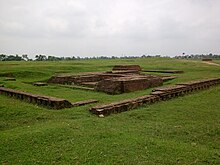Karnasuvarna
কর্ণসুবর্ণ | |
 Remains of Raktamrittika Vihara, c. 600 CE | |
| Location | West Bengal, India |
|---|---|
| Type | Settlement |
| History | |
| Founded | 7th century AD |
| Site notes | |
| Excavation dates | 1929-30, 1962 |
| Archaeologists | K.N.Dixit, S.R.Das |
| Ownership | Archaeological Survey of India, University of Calcutta |
Karnasubarna (Template:Lang-bn meaning 'Made beautiful by Karna') was the capital of Shashanka, the first important king of ancient Bengal who ruled in the 7th century. After Shashanka's death it was the jayaskandhavara (camp of victory) of Bhaskaravarman, the king of Kamarupa probably for a short period. This is evident from his Nidhanpur copper-plate grant. In the mid-7th century, it was the capital of Jayanaga according to his Vappa Ghoshavata copper-plate grant. The ruins of Karnasubarna have been located at Kansona in the present Murshidabad district in the Indian state of West Bengal.[1][2] It is 9.6 kilometres (6.0 mi) south-west of Baharampur, headquarters of Murshidabad district.[3]
Legend has it that Karnasubarna was the capital of the 'Anga' Kingdom that the Kaurava prince Duryodhana had given to the magnanimous Karna, the first born of Kunti.
Excavations at Rajbaridanga
The famous Chinese traveler Xuanzang mentioned in his travelogues about Lo-to-mo-chi (Raktamrittika) Mahavihara, an important centre of learning of Vajrayana Buddhists near Karnasuvarna. It has been identified with Rajbaridanga. The archaeological site of Rajbaridanga is about 2.4 km from Karnasubarna railway station (earlier known as Chiruti) on the Azimganj-Katwa section of Eastern Railway. Local transport like cycle vans are available. This site was first excavated by a team from the Department of Archaeology, University of Calcutta in 1962 under the direction of S.R. Das.[4] Amongst the findings, the most significant one was a monastic sealing bearing the legend Shri Rakta(m)rttika (Ma)havaiharik arya bhikshu (samgha)s(y)a (of the community of venerable monks residing in the Shri Raktamrittika Mahavihara). The other significant findings are terracotta figurines and ornamental stucco mouldings including human heads. Two other sites close by have been excavated at Rakshashidanga (in 1929-30 by K.N. Dixit of the Archaeological Survey of India) and Nil Kuthi.[5]
See also
References
- ^ Ray, Nihar Ranjan, Bangalir Itihas Adi Parba, (in Bengali), 1980 edition, pp. 160-161, Paschim Banga Niraksharata Durikaran Samiti
- ^ Sengupta, Nitish, History of the Bengali-speaking People, p.25, UBS Publishers’ Distributors Pvt. Ltd.
- ^ Majumdar, Dr. R.C., History of Ancient Bengal, first published 1971, reprint 2005, pp. 5-6, Tulshi Prakashani, Kolkata, ISBN 81-89118-01-3.
- ^ Ghosh, A. (ed.) (1965). "Indian Archaeology 1962-63 - A Review" (PDF). Archaeological Survey of India. p. 46. Retrieved 2009-10-26.
{{cite web}}:|first=has generic name (help) - ^ "Karnasubarna". Rangan Datta, free-lance travel writer and photographer. Retrieved 2009-09-23.
External links
 Murshidabad travel guide from Wikivoyage
Murshidabad travel guide from Wikivoyage


